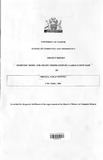| dc.description.abstract | Authentication is determining an individual's identity correctly from among many, mostly through
observing unique physiological features like face or presentation of a token that is unique for every
individual. While these techniques work well for small populations, a challenge arises when the size of the
population is large, as is the case with institutions of higher learning, during examinations.
In Kenyan institutions of higher learning, examinations are conducted in lecture halls and student
populations may go up to 500 students per sitting. In such cases large auditoriums are used and several
invigilators are positioned at the entrance before students enter the hall.
Students are authenticated by providing their student ID card and an examination card. The student ID
contains the student's photograph, student's admission number, his/her names, the degree program
undertaken and course duration.
The examination card contains the student's admission number, the student names the degree program and
examination series. An examination card is not authentic if the exam series is invalid. Authentication
ensures that only bonafide students are allowed into the examination facility.
The process begins shortly before the scheduled time for the examination and it involves checking to
confirm that the photograph on student ID matches the bearer's facial features and that the examination
card is valid before the student is allowed into the examination facility.
The problem with this mode of authentication is the time it takes to take such a population through this
process and its effectiveness in terms of ensuring that no impostor ends up doing an examination. In trying
to beat the time constraint so that the examination starts on time, the invigilators may quickly rush through
the authentication and fail to scrutinize the documents for authentication. Furthermore for such large
populations as is the nature of humans fatigue is bound to kick in thus worsening the situation.
This project seeks to address this problem by using fingerprint biometric technology. Biometric
technologies are automated methods of verifying or recognizing the identity of a living person based on a
physiological or behavioral characteristic. (Nanavati,2002).
In this project a biometric system is developed to authenticate individuals using their fingerprints which are
difficult to forge. It is designed to reduce the time it takes for manual authentication by incorporating
biometric readers at the point of entry into an examination facility which capture the sample and quickly
compares it with a stored template, if a match is found the student is allowed otherwise he/she is rejected.
The findings of this project show that the time taken to perform manual authentication is twice the time
taken using the system. | en |

